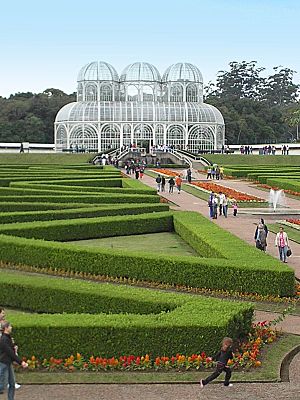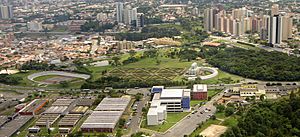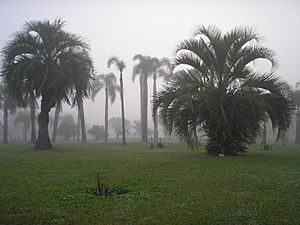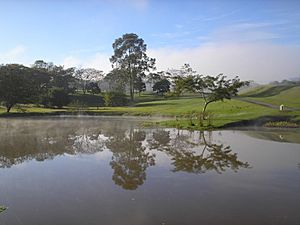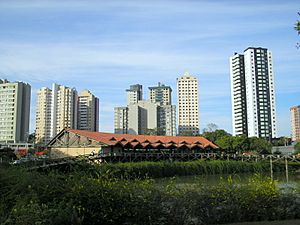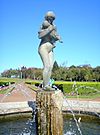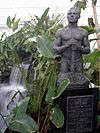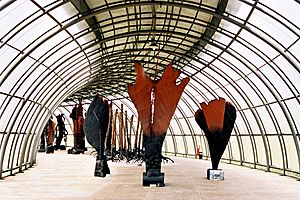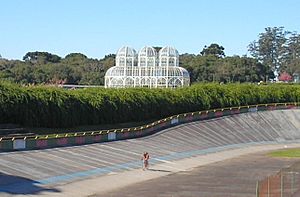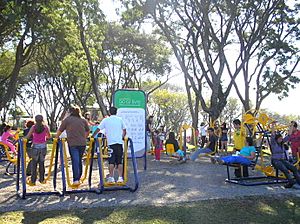Botanical Garden of Curitiba facts for kids
|
|
|
| Location | Curitiba, Paraná, South Region of Brazil. |
| Size | 178.000 m² |
| Opened | 1991 |
| Annual visitors | 1.000.000 |
| Website | Jardim Botânico de Curitiba |
The Botanical Garden of Curitiba (Portuguese: Jardim Botânico de Curitiba) is a famous park in the city of Curitiba, Brazil. It is also known as the "Jardim Botânico Fanchette Rischbieter". This beautiful garden is located in the Jardim Botânico district. Curitiba is the capital city of the state of Paraná, and the largest city in southern Brazil.
This garden is the most popular tourist attraction in Curitiba. In 2007, people voted for it as one of the "Seven Wonders of Brazil" in an online election. The Botanical Garden is also home to part of the Federal University of Paraná. It has become a well-known symbol for the city and for all of southern Brazil. Its international code is CURIT.
Contents
History of the Curitiba Botanical Garden
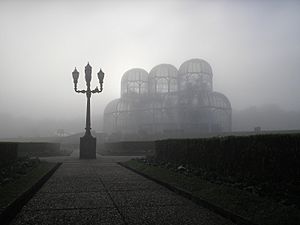
The very first botanical garden in Curitiba was called the Passeio Público. This means "Public Promenade Park." It opened in the 19th century. The President of Paraná Province, Alfredo d’Escragnolle Taunay, officially opened it. It was the city's first public park.
Why is it called Fanchette Rischbieter?
The garden's official name is "Jardim Botânico Fanchette Rischbieter." This name honors Francisca Maria (Fanchette) Garfunkel Rischbieter (1929-1989). She was a pioneer in urban planning for Curitiba. This means she helped design how the city would grow and develop.
When was the Curitiba Botanical Garden opened?
The current Botanical Garden opened on October 5, 1991. It was built during the time Jaime Lerner was the Mayor of Curitiba. The garden was created on what used to be an old dump. Its design was inspired by French gardens.
The geometric flowerbeds were designed to look like the city's flag. You can see this clearly from above. The greenhouses are made of iron and glass. The main greenhouse was inspired by the Crystal Palace. This famous building existed in London in 1851. The architect Abraão Assad designed the greenhouses. He also planned the Botanical Museum.
Exploring the Curitiba Botanical Garden
The Botanical Garden of Curitiba is a famous landmark. It has many plants from Brazil and other countries. These plants are spread out along boulevards and in greenhouses. The main greenhouse has an art nouveau style. Its modern metal structure looks like the Crystal Palace in London, England.
When you enter, you see large French-style gardens. There are also fountains, waterfalls, and lakes. The main greenhouse is 458 square meters. Inside, it holds plants from tropical regions. A "carpet" of flowers greets visitors at the entrance. There are six geometric gardens, each with four flowerbeds. These are lit by chandeliers and filled with seasonal flowers. The garden covers 278,000 m².
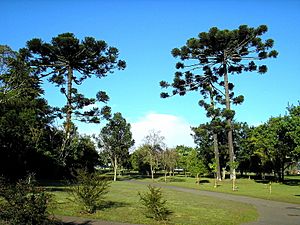
The native forest has many paths for walking. Behind the main greenhouse is the Museum of Franz Krajcberg. He was a Polish-Brazilian artist who cared deeply about the environment. This museum has 1,320 square meters of space. It includes multimedia classrooms and an auditorium. There are also exhibitions of his sculptures, photographs, and videos.
On the other side is the Botanical Museum. It is a wooden building with a wooden bridge leading to it. The museum has the fourth largest herbarium in Brazil. In front of it, there is a pond with carp, turtles, teal, and herons. The park also has tennis courts and a cycle track.
Plant Collections and Conservation Efforts
The Botanical Garden is more than just a beautiful place. It is also a research center for the plants of Paraná. It helps with environmental education and protecting nature. Like all botanical gardens, it grows, protects, studies, and reproduces many different plants.
In 2008, another greenhouse was built. This one is for research and protecting rare Brazilian plants. It is not open to the public. It helps prevent these plants from disappearing from nature. This greenhouse is made of polycarbonate and has its own irrigation and temperature control system.

Garden of Native Plants
The Garden of Native Plants of Curitiba was created in 2007. Every plant in this garden is native to the area, even the grass. Because it has no exotic plants, it attracts many butterflies and other pollinating insects.
The Atlantic Forest used to be the second largest forest in Brazil. Now, less than 5% of it remains. The native vegetation of Curitiba is the araucaria moist forest. This is a subtropical forest that is now one of the most endangered biomes in the world. It makes up about 40% of the plants in the Botanical Garden. The park was created to help protect this biodiversity.
Near one of the lakes, 200 seedlings of trees and shrubs were planted. These are native to the Serra do Mar of Paraná. The Serra do Mar is a long system of mountain ranges along Brazil's Atlantic coast. Some of these plants were grown on the coast and then moved to the garden.
Seasonal Blooms and Special Gardens
Every year in July, the prunus serrulata blossoms. There are about 30 of these trees along a path in the park. Japanese immigrants first brought these seedlings to Curitiba in the early 20th century. They began to be planted in large numbers in the 1990s. Now, the city grows these seedlings for planting on streets and in squares.
The Jardim das Sensações (Garden of Sensations) opened in 2008. It is a 200-meter track where visitors can walk without their vision. This allows them to experience plants using their other senses. More than 70 plant species with different smells, textures, shapes, and sizes fill the path.
This garden covers 2381 square meters. It is surrounded by trees that block outside noise. A bamboo fence hides it to keep it a surprise. All parts of the track have labels in Braille for blind visitors. Small groups can explore the path with or without a blindfold. About 5,000 people visit this garden each week.
The Botanical Museum of Curitiba
The Museu Botânico de Curitiba is located inside the Botanical Garden. It has a large area for exhibitions, a library, and an auditorium. It was founded in 1965. This happened when the botanist Gerdt Günther Hatschbach gave his private collection to Curitiba. Today, the museum's collection is the fourth largest in Brazil. It has over 333,000 plant specimens.
The museum trades botanical materials with 207 institutions worldwide. Because of this, about 90% of its collection has been identified by experts. This makes the Botanical Museum of Curitiba a global reference for plant materials. Each year, about 400 research scientists and students visit the museum. The collection grows by about 15,000 new specimens every year.
Art and Culture at the Garden
Sculptures in the Garden
Amor Materno (Maternal Love) is a bronze sculpture by Polish artist João Zaco Paraná. It is placed in a fountain. He made this sculpture in 1907. The Polish community in Brazil donated it in 1993. This was to honor all mothers from Paraná during the city's 300th anniversary. Zaco Paraná moved to Brazil in 1896. He created many monuments and statues in Brazil and around the world.
Torso do Trabalhador (Worker's Trunk) is another bronze sculpture. It was made by artist Erbo Stenzel from Paraná. This sculpture is inside the glasshouse, also in a fountain. It was created in 1941 and placed in 1994. It honors workers worldwide. This was done when Curitiba hosted the World Habitat Day in 1995. This event reminds us of our shared responsibility for the habitat for future generations. Erbo Stenzel created many sculptures of political figures and local culture.
Frans Krajcberg Cultural Space
The Frans Krajcberg Cultural Space is located behind the main greenhouse. It was originally planned to be an orchidary. In 2003, it began to house artworks. These include 110 large sculptures made from burned or illegally cut trees. There are also reliefs, photographs, videos, and texts. The artist named his collection "The Revolt." This shows his feelings about the destruction of Brazilian forests. The space also has photos by the sculptor and books about him. Its main goal is to raise environmental awareness. All the works were donated by the artist.
Krajcberg was born in Poland in 1921. His Jewish family disappeared in the Holocaust. He moved to Brazil in 1948 and became a Brazilian citizen. He won many awards globally. The Curitiba Botanic Garden was the first place designed specifically to show his works. About 60,000 people visit this gallery each year.
The Botanical Garden as a City Symbol
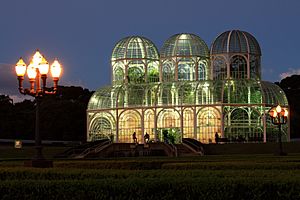
The new Botanical Garden was one of many projects by Mayor Jaime Lerner. He created the slogan "The Ecological Capital of Brazil" for the city. The garden quickly became an icon of Curitiba. The image of its main greenhouse is often used in advertising for the city. It is now the unofficial symbol of Curitiba and all of southern Brazil.
Other buildings have been inspired by the greenhouse. A mall in Concórdia, Santa Catarina state, looks like it. The Shopping Pátio Higienópolis in São Paulo City also shows its influence. The logo for Curitiba's bid to host the 2014 FIFA World Cup was also inspired by the greenhouse.
Thematic Lighting Events
The greenhouse is used for many special events. Since 2008, its lights are turned off for one hour for Earth Hour. This is a global event by the World Wide Fund for Nature (WWF) in March. Every October, the greenhouse is lit with pink lights. This supports Breast Cancer Awareness Month. In December, it has Christmas decorations as part of the "Christmas of Light" event.
In 2011, for 1,000 days until the 2014 World Cup, the greenhouse was lit with the colors of flags of past World Cup winners. These included Brazil, Italy, Germany, Uruguay, Argentina, England, France, and Spain. That same year, Curitiba joined the Decade of Action for Road Safety by the United Nations. The greenhouse was lit in yellow, which means "attention" in traffic.
-
The Earth Hour 2010.
-
Colors of Brazilian Flag in 2010, due to World Cup.
-
The Pink October.
Sports and Leisure Activities
The park offers Wi-Fi in many areas. To use the free wireless internet, you need to register on the Passport Curitiba website.
The Curitiba Velodrome
The Irineu Marinho Velodrome opened in 1979. It is also known as the Curitiba Velodrome. It was the first velodrome in Brazil to have a public cycling school. Its measurements are Olympic standard, at 333.33 meters long. It hosts national and international competitions.
The velodrome was updated in 1982 and had a major renovation in 2002. Its coaches have helped train many of Brazil's best cyclists. These athletes represent the state and country in national, international, and Olympic championships.
The Velodrome Center for Sport and Leisure This center includes the velodrome cycling track. It also has courts for beach football and sand volleyball. There are three tennis courts as well. The center offers activities led by physical education teachers. These activities include gymnastics, walking, and cycling. In 2010, a free outdoor gym was added. It is open to everyone.
Location and Visiting Information
The Botanical Garden is located on Eng. Ostoja Roguski Street, s/n°, in the Jardim Botânico Neighborhood of Curitiba, Paraná, Brazil. It is open daily to visitors. During summertime, it is open from 6 am to 9 pm. The rest of the year, it is open from 6 am to 8 pm. You can call them at +55 (41) 3362-5289.
Images for kids
-
Skyline of Curitiba by Botanical Garden at night.
-
Plants inside the greenhouse
-
Inside the Frans Krajcberg Gallery
See also
 In Spanish: Jardín botánico de Curitiba para niños
In Spanish: Jardín botánico de Curitiba para niños


